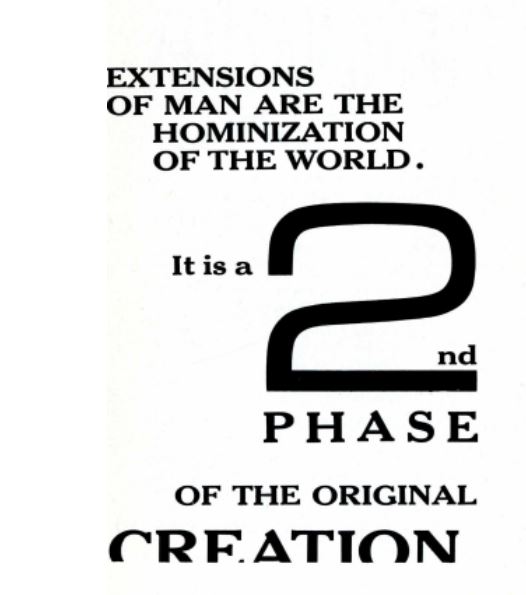This is page 34 of the 1969 Counterblast. The missing bottom “phase” of “creation” is original.1
In the posthumous The Global Village, the same thoughts appear again in only slightly modified form:
The media extensions of man are the hominization of the planet; it is the second phase of the original creation.2
McLuhan saw satellites as that particular ‘extension of man’ best illustrating such hominization:
Satellites (…) transform the planet into a work of art by placing it inside a man-made environment… (Take Today, 294)
When the planet was suddenly enveloped by a man-made artifact, “Nature” flipped into art form. (The End of the Work Ethic, Address to The Empire Club of Canada, November 16, 1972)
A satellite was a kind of mini-planet that could support life, like the planet beneath our feet, but one that was entirely “man-made”. It thereby prompted a different take on Earth itself and ecological consciousness was born:3
The moment of Sputnik was the moment of creating Spaceship Earth… (The End of the Work Ethic)
But even before Sputnik’s launch in 1957, McLuhan had seen the same phenomenon already at work since the scientific and industrial revolutions. Here he is already in Explorations 2 in 1954:
Technology has abolished ‘nature’ in the old sense and brought the globe within the scope of art. (Notes on the Media as Art Forms)4
In fact, once technology was conceived as the domain of human extensions, the abolition of nature and hominization of the planet must have occurred already with those first extensions of paleolithic “humanoids”, speech and stone tools:
The first humanoid uttering his first intelligible grunt, or “word,” outered himself and set up a dynamic relationship with himself, other creatures, and the world outside his skin. Speech (…) is (…) a tool to reconstitute nature (…) to translate one form [nature] into another [human experience and its collective expression in culture].5 (…) The pre-neolithic [= paleolithic] art of making stone tools [like the art of making speech tools] moved man out of the process of [natural] evolution and into a world of his own making. (The Global Village, 1989, p93)
Humans qua humans — humans as humans — are fundamentally creative in this way:
In ordinary perception men perform the miracle of recreating within themselves, in their interior faculties, the exterior world. This miracle is the work of the nous poietikos or of the agent intellect — that is, the poetic or creative process. The exterior world in every instant of perception is interiorized and recreated in a new matter. Ourselves. (Catholic Humanism and Modern Letters, 1954)
Hence, even with paleolithic “humanoids”, or especially with paleolithic “humanoids” (since a beginning exceeds the development it enables and shapes), a ‘new’ factor is operative in the world. Things no longer follow a purely ‘natural’ course. Through the exercise of creativity even, or especially, in “ordinary perception”, ever repeated leaps of creativity punctuate nature in such a way that the physical course of events is inter/rupted.
“In every instant” ruptures occur. The gap is where the action is.
Here McLuhan is close to the Epicurean view of Lucretius (c99 BC – c55 BC) in De rerum natura:
Where do we get that freewill, wrenched away
From the fates, by which we each proceed to follow pleasure’s sway,
So that we swerve our motions not at a designated spot
And fixed time, but the very place we will it in our thought?
Without a doubt these motions have their beginning in the whims
Of each, and from that will these motions trickle into the limbs.6
With all living beings, but especially with humans, a decided clinamen (swerve) is seen to operate in the world alongside, but exceeding in some way, the world of nature, the world of the natural ‘course of events’.
.
- Harley Parker’s fontwork here is well conceived. The labyrinthine shape of the ‘2’ traces the complications of creation and the analogous complications of thought that would ‘follow’ it. Meanwhile the halving of ‘creation’ illustrates that “original creation” is not the full story. As McLuhan says, a “second phase” is essential to it. Furthermore, creation in both its divine and human iterations takes place across a gap — amounting to an absence that is essential to creation. The very heart of creativity is a gap “where the action is”. This gap is what must be retraced and retrieved today after centuries in which it has been largely ‘overlooked‘ (as the top half of Parker’s “creation” overlooks its missing bottom “phase”). ↩
- The Global Village, 1989, p93. ↩
- Compare ‘At the moment of Sputnik the planet became a global theatre in which there are no spectators but only actors’, 1974: “At the moment that the earth went inside this new artifact, Nature ended and Ecology was born.” ↩
- In the same 1954 essay (‘Notes on the Media as Art Forms’): “The power of the machine to transform the character of work and living strongly invites us to transform every level of existence by art.” ↩
- ‘Speech is a tool to reconstitute nature, to translate one form into another’. Compare ‘Catholic Humanism and Modern Letters’ (cited in part above): “In ordinary perception men perform the miracle of recreating within themselves, in their interior faculties, the exterior world. This miracle is the work of the nous poietikos or of the agent intellect — that is, the poetic or creative process. The exterior world in every instant of perception is interiorized and recreated in a new matter. Ourselves. And in this creative work that is perception and cognition, we experience immediately that dance of Being within our faculties which provides the incessant intuition of Being.” ↩
- Bk2.257ff:
unde est haec, inquam, fatis avolsa voluntas,
per quam progredimur quo ducit quemque voluptas,
declinamus item motus nec tempore certo
nec regione loci certa, sed ubi ipsa tulit mens?
nam dubio procul his rebus sua cuique voluntas
principium dat et hinc motus per membra rigantur. ↩
